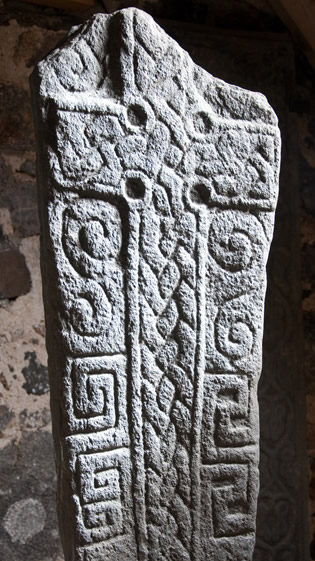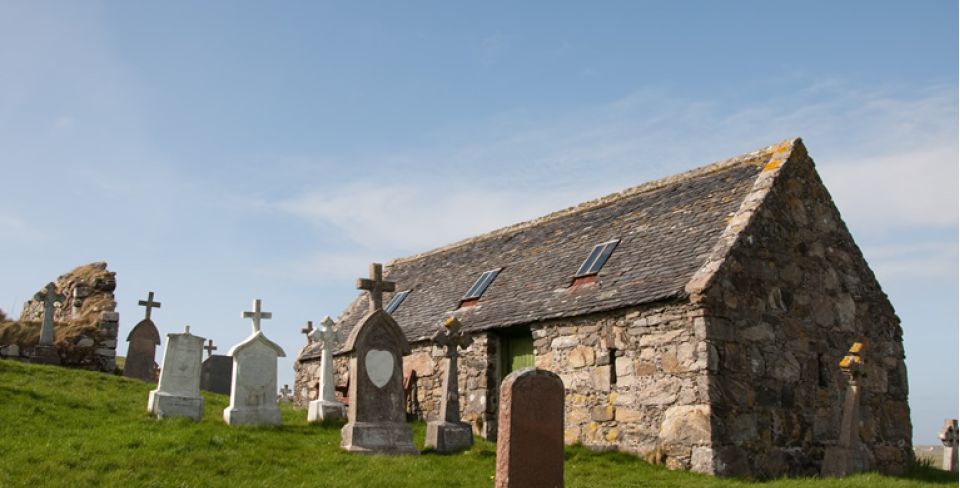9.11 Kilbar Church, Barra
Cill Bharra is the remains of a 12th century church dedicated to St Barr. The site is thought to have been used for Christian worship since the 600s when there was a chapel here dedicated to St Barr – probably the same saint as St Finbarr of Cork.
Parts of the north and south walls of Kilbar Church are still standing. You can see the remains of the original door in the north wall. Alongside there is one remaining ruined wall of another chapel dating from the 1400s.
The North Chapel was probably built in the 16th century and is the only roofed building left on the site. Inside there is replica of the Kilbar Stone which dates from some time between 900 and 1100.

On one side there is a Christian cross. On the rear is an inscription in Nordic runes written from top to bottom in three lines. The runes are transcribed as:-
…(t)ir·þ:ur·kirþu:s(t)in(a)r …r·is·kurs:sia(:)rstr …(k)a
making the sentence:-
…eftir Þorgerðu Steinar’s dóttur es kors sjá reistr
which translates as:-
‘In memory of Þorgerðr Steinarsdóttir is the cross raised’ or ‘This cross was raised in memory of Thorgerth, daughter of Steinar’.
Runes, ogham and latin were the three written scripts used during this period. Runes come from Scandinavia. Ogham was used by the Irish, Picts and Scots – an ogham inscription can be found at the Pictish fort of Dunadd. Latin was the language of the Christianity and spread with the faith. But most people could neither read nor write.
The cross is carved from local stone and is 1.36m high. The stone is unusual in combining both Christian and Nordic symbols. The Kilbar stone was found here but the original is now in the National Museum of Scotland.
The North Chapel also contains four graveslabs belonging to the MacNeill chiefs. These stones were carved by men from Iona and Oronsay and are similar in style to those found all along the west coast of Scotland. (See Iona, Kilmartin Church, Keills Chapel, Kilmory Knap Chapel in Argyll.)
Writing in 1703 in his ‘Description of the Western Isles’ Martin Martin says,
‘The natives have St. Barr’s wooden image standing on the altar, covered with linen in form of a shirt; all their greatest asseverations are by this saint. I came very early in the morning with an intention to see this image, but was disappointed; for the natives prevented me by carrying it away, lest I might take occasion to ridicule their superstition, as some Protestants have done formerly; and when I was gone it was again exposed on the altar.
Local tradition tells a story that St Barr was a follower of Colmcille who came to Barra to convert the islanders. A previous missionary had been burnt and eaten but St Barr managed to bring Christianity to Barra. When it was time for him to leave the island, St Barr prayed for the islanders and when he had gone, a statue was erected of him. In 1625, Father Cornelius Ward notes that he saw a statue of St Barr in the church at Kilbar. The islanders celebrated the saint’s day with a holiday from work and horse racing and shinty matches until the mid 19th century. By the mid 20th century, local people with friends or relatives buried at St Barr would still mark the saint’s day with a day of rest.
Outer Hebrides
- 9.1 St Columba’s Church, Isle of Lewis
This late 14th century church - named after St Columba - was later extended in the 15th and 16th century. St Columba’s was the principal church on Lewis in medieval times. It was built by the MacLeods and dedicated to Colmcille. Its importance may have been connected to its position...
- 9.2 St Moluag’s Chapel, Eoropie, Isle of Lewis
Eoropie township is on the northwest tip of the Isle of Lewis. It is the most northerly township in the Outer Hebrides. This restored chapel is dedicated to St Moluag or Moluoc. The building is flanked by two small side chapels to the north and south, creating a T-shaped outline....
- 9.3 St. John’s Chapel, Bragar, Isle of Lewis
Head west from the crofting township of Bragar to find the medieval chapel of Teampull Eoin - St John The Baptist - on a small headland next to the beach. The ruins of the chapel lie within a graveyard that is still in use today. The building was in two parts -...
- 9.4 Uig Peninsula, Isle of Lewis
Taigh a’Bheannaich, Gallan Head, Aird, Uig The name of this chapel translates as ‘House of the Blessed or the Benediction’. It’s unusual because it is not dedicated to an individual saint. Unlike many of the other locations on this trail, the chapel is high on a cliff rather than being...
- 9.7 St Clements, Rodel, Isle of Harris
This is the largest medieval church in the Outer Hebrides. Of all the churches in the islands, only Iona is larger. It was built in the 16th century but there is some suggestion that there may have been an older monastery on the site. The church was restored in 1873...
- 9.6 Northton Chapel, Toe Peninsula, South Harris
Northton Chapel faces south across the Sound of Harris looking towards the Uists. It sits on a small headland - Rubh’ an Teampull - at the foot of Ceapabhal hill. The chapel is in a stunning location and is reached by a 2.5km walk across grassland. The chapel is late...
- 9.5 Teampall Chaluim Chille, Eilean Chaluim Chille, Isle of Lewis
The small island of Eilean Chaluim Chille has probably been connected with Christianity since the 7th century. It sits on the eastern extremity of Loch Erisort as it leads out to the Minch. The remains of the church on the island probably date from the 12th century. Any earlier church...
- 9.8 Church of the Holy Trinity, Carnish, North Uist
Teampull na Trianaid (Church of the Holy Trinity) sits on a mound beside the village of Carinish. There are views west towards the low-lying island of Baleshare The remains of the Teampull na Trianaid dominate the site. There was probably a series of settlements on this site before the chapel...
- 9.9 Chapel of the Virgin Mary, Nuntown, Benbecula
The ruined medieval chapel sits in a graveyard which is still in use. The chapel was rectangular and would have had a pitched roof. The walls would have been much higher - you can see the top part of the door in the west wall. According to oral tradition, this...
- 9.10 Howmore, South Uist
The township of Tobha Mor - or Howmore - lies between the main North-South road on South Uist and the beach which forms much of the island’s west side. In among the thatched houses of Howmore are the ruins of a church and four chapels. Writing in 1703 in his...
- 9.11 Kilbar Church, Barra
Cill Bharra is the remains of a 12th century church dedicated to St Barr. The site is thought to have been used for Christian worship since the 600s when there was a chapel here dedicated to St Barr - probably the same saint as St Finbarr of Cork. Parts of...










Bòrd na Gàidhlig
Great Glen House
Leachkin Road
Inverness
Scotland, IV3 8NW
(+44) 01463 225454
colmcille@gaidhlig.scot
Colmcille
Foras na Gaeilge, 2-6 Queen Street
Belfast
Northern Ireland
BT1 6ED
(+44) 028 9089 0970
colmcille@forasnagaeilge.ie
Colmcille
Foras na Gaeilge, An Chrannóg
Na Doirí Beaga
Gaoth Dobhair
Donegal, Ireland. F92 EYT3
(+353) 074 9560113
colmcille@forasnagaeilge.ie


